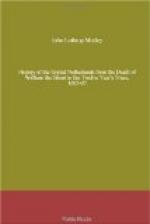Both rose as the friar entered, and greeted him with cordiality.
“But,” said the prince, “how did you dare to enter the Hague, relying only on the word of a Beggar?”
“Who would not confide,” replied Neyen, “in the word of so exalted, so respectable a Beggar as you, O most excellent prince?”
With these facetious words began the negotiations through which an earnest attempt was at last to be made for terminating a seemingly immortal war. The conversation, thus begun, rolled amicably and informally along. The monk produced letters from the archdukes, in which, as he stated, the truly royal soul of the writers shone conspicuously forth. Without a thought for their own advantage, he observed, and moved only by a contemplation of the tears shed by so many thousands of beings reduced to extreme misery, their Highnesses, although they were such exalted princes, cared nothing for what would be said by the kings of Europe and all the potentates of the universe about their excessive indulgence.”
“What indulgence do you speak of?” asked the stadholder.
“Does that seem a trifling indulgence,” replied John Neyen, “that they are willing to abandon the right which they inherited from their ancestors over these provinces, to allow it so easily to slip from their fingers, to declare these people to be free, over whom, as their subjects refusing the yoke, they have carried on war so long?”
“It is our right hands that have gained this liberty,” said Maurice, “not the archdukes that have granted it. It has been acquired by our treasure, poured forth how freely! by the price of our blood, by so many thousands of souls sent to their account. Alas, how dear a price have we paid for it! All the potentates of Christendom, save the King of Spain alone, with his relatives the archdukes, have assented to our independence. In treating for peace we ask no gift of freedom from the archdukes. We claim to be regarded by them as what we are—free men. If they are unwilling to consider us as such, let them subject us to their dominion if they can. And as we have hitherto done, we shall contend more fiercely for liberty than for life.”




